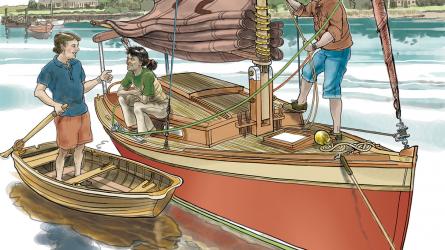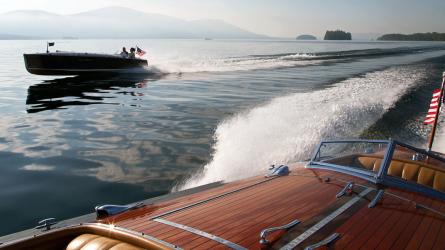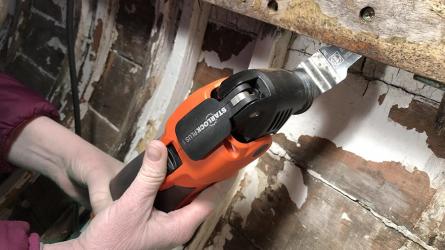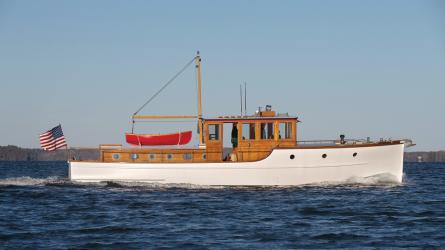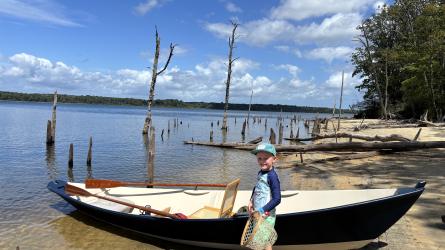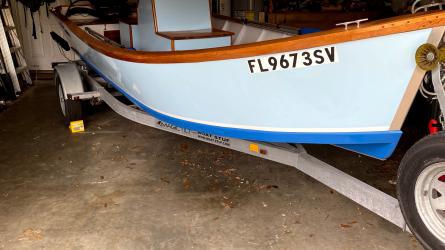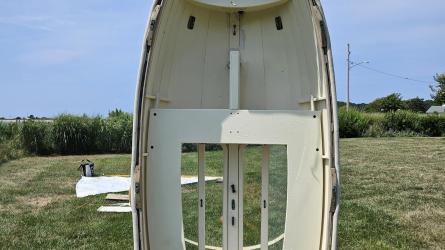Other People’s Boats: How Most People “Get Started”
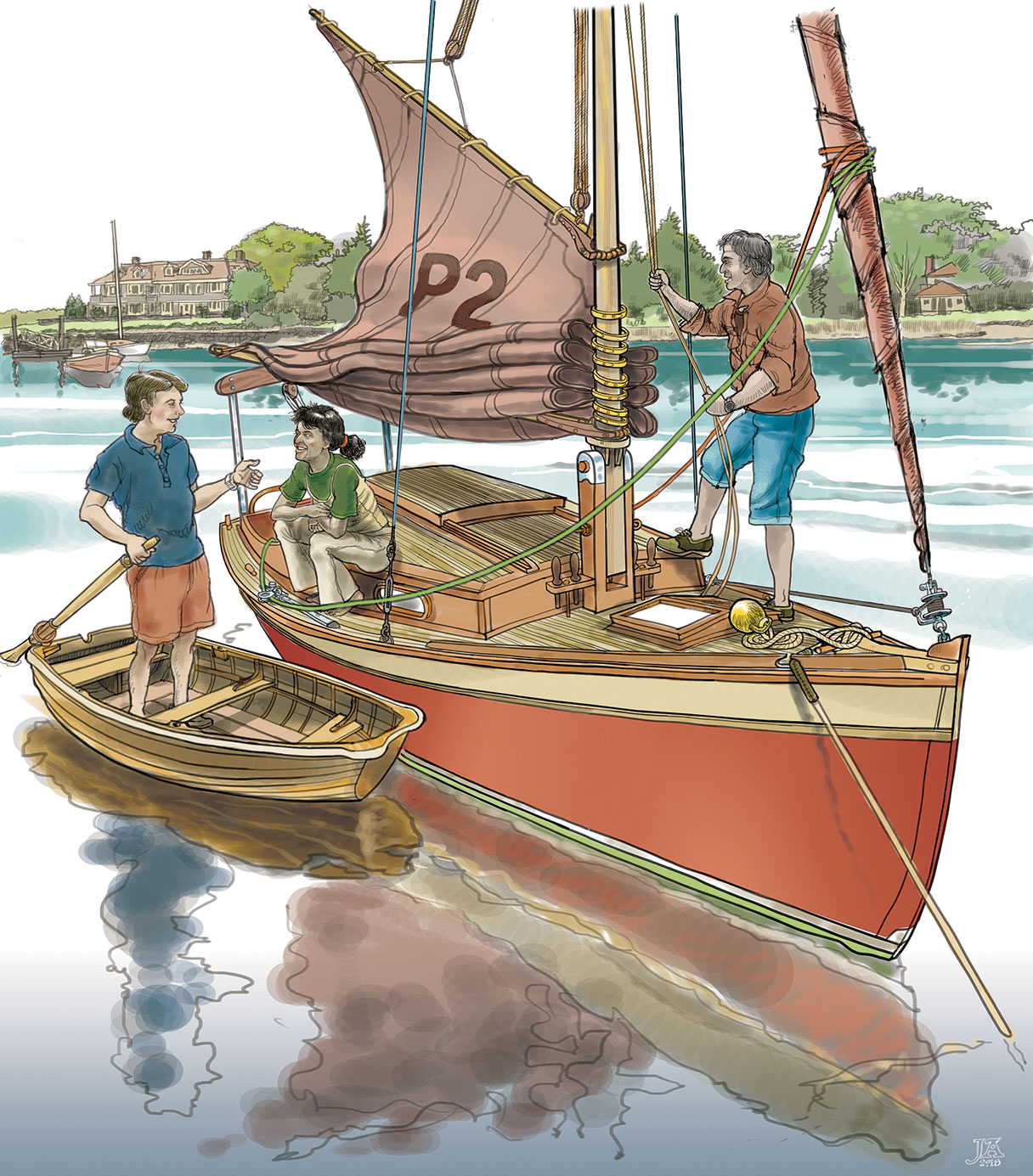
In this space, we often speak as though our reader already owns a boat with which they can exercise maintenance or navigation skills. However, the editors realize that, when getting started, we have all been lucky to have found opportunities aboard other people’s boats. In fact, the term “OPB”—for other people’s boats—is a lighthearted reference among experienced sailors to the concept of enjoying sailing without shouldering the cost of it. For many people, the seeds of the rewarding experience of ownership are planted when one is invited to sail in somebody else’s boat.
A little kindling in the form of an open invitation goes even further for some, and might eventually spark great and long-lasting professional maritime careers. There are many admirable people we can think of who share that common past: they answered the call for volunteers or emphatically said yes when they were extended a hearty welcome from an experienced salt. We’ve highlighted a few of them in the following pages. Here are ideas for how you, at any age and in any location, can get aboard to sail, get your hands dirty maintaining, or garner skills for building before you ever think of digging into your wallet to own a boat. The best boats for a beginner, truly, are Other People’s Boats.
Joining Racing or Boating Clubs
While yacht clubs may appear to be exclusive social domains walled-off to outsiders, they are, in fact, all founded on the simple premise of providing access to sailing and powerboating through a common portal. Any club worth its salt has a bulletin board on which one can pin an advertisement seeking crew, or seeking the opportunity to crew. This is a great way for a somewhat-experienced sailor with no club affiliation to gain racing skill and delivery opportunities. While one must respect the fact that a club’s facilities exist for the benefit of its members, a simple visit or telephone call to the reception desk will reveal the protocols for approaching members in need of crew.
Furthermore, many yacht clubs now offer sailing lessons to children and adults from their greater community—people who are not card-carrying members. In some cases, these lessons are either offered for free, or are sponsored by a local foundation. While participation in such lessons does not grant one access to the bar, tennis courts, pool, and snack bar, they provide a great introduction to sailing, and the sailing community. Check your local club’s website, or call and ask; you might just be surprised at the opportunities available to non-members of yacht clubs.
Many urban areas have community boat centers. One of the oldest and best-run is an organization called Community Boating in Boston, founded in 1930. Its stated mission is to provide “Sailing for All”—regardless of financial means, ability, or age. Although its boats are fiberglass, it offers rentals and lessons in a fleet of classic designs, including the Rhodes 19 and Cape Cod Mercury.
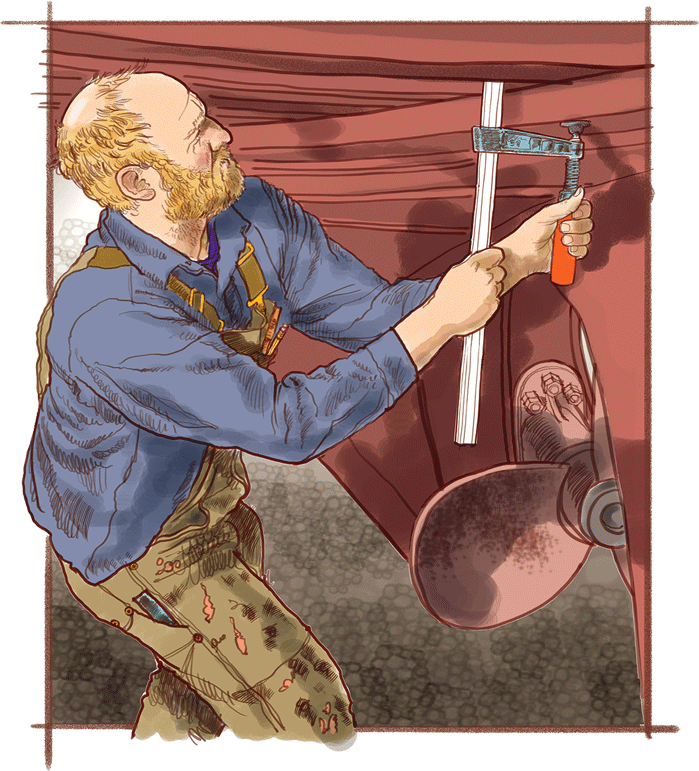
Brad Seamans, volunteer for ADVENTURESS.
Tall-Ship Sailing
We have encountered many vessels over the years in which young volunteers make up a majority of the crew. All find genuine camaraderie, and some have life-changing experiences. Getting started as crew may be as simple as asking, or checking a website for a drop-down menu that contains the word “volunteer.”
A lot of tall ships these days have the dual purposes of teaching seamanship skills and environmental awareness. They take paying passengers but also rely on volunteer crew. The mother of such programs is the Hudson River sloop CLEARWATER, which depends on a cadre of volunteers not only for sailing but also for repair and maintenance (which we’ll take up in the next section). The century-old schooner ADVENTURESS in Port Townsend, Washington; SULTANA, a re-creation of a Colonial schooner on Chesapeake Bay; and the historic working ships GAZELA OF PHILADELPHIA and A.J. MEERWALD of New Jersey are all examples of programs that carry on this tradition.
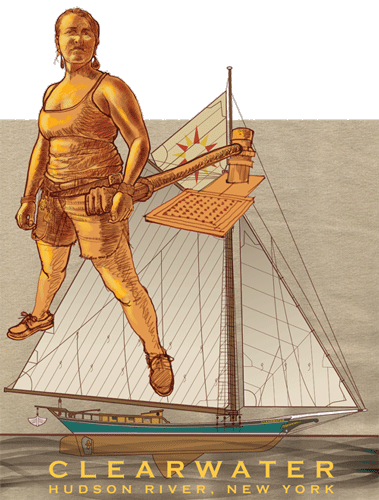
OPB All-Star: Aleythea Dolstad
It can be a small world. For example, a former ADVENTURESS volunteer, a second-generation one, Aleythea Dolstad, is now one of the professional captains aboard CLEARWATER.
“I came on ADVENTURESS as a participant for a ‘Fantastic Voyages’ trip in the summer of 2000 and returned the next summer as a volunteer crew for two weeks.” Dolstad kept coming back. “One spring, the captain told me I was not allowed to volunteer anymore. I had to get paid. Captain’s orders.” On CLEARWATER, which inspired ADVENTURESS’s educational program, Dolstad served as bosun, first mate, and finally captain. From here, their career could go just about any direction.
“Many vessels have fantastic volunteer programs that allow people of all ages the opportunity to check out what it is like to work on these amazing ships,” Dolstad said. “On CLEARWATER, each week we have a new set of up to six volunteers, age 16 on up. These volunteers are what makes the program work. I cannot state that strongly enough. They help with the education, sailing, and daily aspects of running the vessel, as well as bring new life to each week.
“Volunteering on ADVENTURESS was a wonderful experience for me as a young person that truly shaped who I am today. I had the privilege to take advantage of that opportunity, and I recognize more and more how lucky I was to have that privilege. If I could stress one point, it would be the importance of providing opportunities to those who do not have the privileges I had when I started volunteering. I believe it is important to fund more opportunities so those who cannot afford to volunteer can experience incredible worlds such as tall-ship sailing.”
Take the schooner ADVENTURESS as just one example. A true community has grown around the ship and her care (see WB No. 232). Each winter a flock of volunteers descends on Port Townsend to scrape, sand, and repaint her bottom; to sand and varnish her brightwork; to overhaul her rigging blocks under the supervision of the bosun; and a million other tasks. They couch-surf. They share cooking and cleaning. Above all, they meet other people who share a common passion. And they have a great time. When summer comes, many of them also serve as volunteer deckhands.
Opportunities abroad can also beckon. In Roskilde, Denmark, the 98′ LOA ship HAVHINGSTEN FRA GLENDALOUGH was built new in 2005 following evidence from an 11th-century ship found by archaeologists. She has a crew of 65, so volunteers are always needed when sailing expeditions are scheduled. Naturally, this is easiest for people nearby; however, volunteers often come from far afield. The membership comes with a fee, but it’s not much—about $120 annually—and is discounted for those 25 or younger. Learning the ship, and its safety systems, is a very real commitment of time. (email havhingsten@live.dk.)
The Viking Ship Museum has not just one but nine such boat “guilds,” each of which gathers volunteers who are dedicated to one of the unique, and very beautiful, boats built or restored at the museum. Many of these have weekly daysails during the season but also venture on long trips. Each guild maintains its boat and takes care of such things as spring fitout and launching.
All ships need maintenance and care, and it is much more common than many people think to find new tall ships being constructed—which leads to our next section.
Boatyard Opportunities
When the Colonial schooner SULTANA was built in Maryland (see WB No. 165), a swarm of volunteers played a key role in her construction, and they continue to help with her annual downrigging and as sailing crew. Every new tall ship has room for volunteer workers. There is no better way to learn something than by working alongside someone with experience, and for those interested in wooden-hull construction, volunteering on maintenance or building can be a wonderful start.
ADVENTURESS is another great example: during her annual haulouts, volunteers work on specific maintenance projects. The shipyard where the work is normally done, Haven Boat Works in Port Townsend, brings in a couple of promising volunteers each year to work alongside the professional shipwrights.
GAZELA OF PHILADELPHIA is a historic ship that draws heavily on volunteer help. The barkentine, built in Portugal in 1901, sails seasonally, and among her crew are volunteers who have put in at least 50 hours of maintenance work for the Philadelphia Ship Preservation Guild. Part of sailing any vessel is taking care of it.
Among the historic fleet at the Northwest Historic Seaport in Seattle, Washington, volunteers also help to maintain the fleet—and some of them even worked alongside diesel engine expert Adrian Lipp, who also was a volunteer, to rebuild the engines of the 1889 tugboat ARTHUR FOSS.
For opportunities in vessel construction, watch for new projects, whether large or small. They come along from time to time, usually under the aegis of nonprofit institutions. One of the most recent ones is the schooner MATTHEW TURNER, which is nearing completion in Sausalito, California. Skipper John Skoriak noted that most recently a crew of young riggers, most of them recent college graduates who are also experienced tall-ship sailors, volunteered to help rig the ship and together swayed her yards aloft for the first time. Working alongside such people could be a treasured experience of a lifetime. The owner, Call of the Sea, Inc., put out a call for volunteers to help during the construction, too, and so far has logged 150,000 hours donated by volunteers. The interior fitout is yet to be completed.
Nobody is going to find a volunteer post in Boston with the USS CONSTITUTION—which is still a commissioned Navy ship—but volunteers do help the associated museum, for example in its Model Shipwright Guild. But probably every other wooden vessel maintained by any museum anywhere in the world would welcome as much volunteer help as possible.
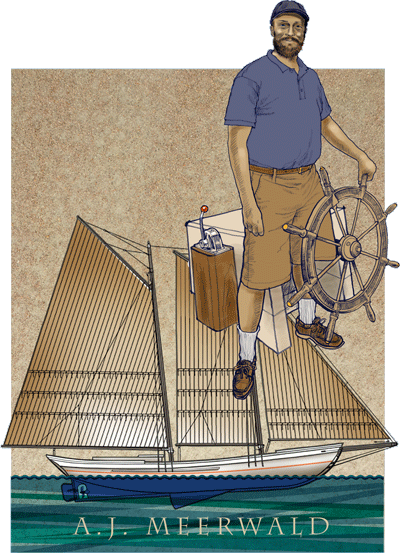
OPB All-Star: Johann Steinke
One American veteran of a 2008 HAVHINGSTEN voyage between Ireland and Denmark was Johann Steinke, who went on to serve, among other things, on schooners in Maine and aboard another Viking ship replica, the 118' LOA Norwegian ship DRAKEN HARALD FAIRHAIR. He served as a professional captain of the replica brig LADY WASHINGTON in Washington State and today is the captain of the historic schooner A.J. MEERWALD in New Jersey. He started off by being a paying customer aboard LADY WASHINGTON. “I was only supposed to be on for two weeks, but the crew liked me, and I liked them. They offered me a job as the ship’s purser (the accountant), so I stayed. I’ve been working on boats off-and-on ever since.”
The MEERWALD, like virtually every other historic vessel, has a strong cadre of helpers. “We are always looking for volunteers,” Steinke said. “During the season, she travels all around New Jersey, roaming to Philadelphia as well as New York City, so there are definitely plenty of chances for folks to sail and help out, and there is usually room for two to five volunteers to overnight if they are traveling a long distance.” Like ADVENTURESS and CLEARWATER, the ship takes interns aboard each year and has both maritime history and environmental education as missions. Woodworking and boat restoration work parties take place every Wednesday.
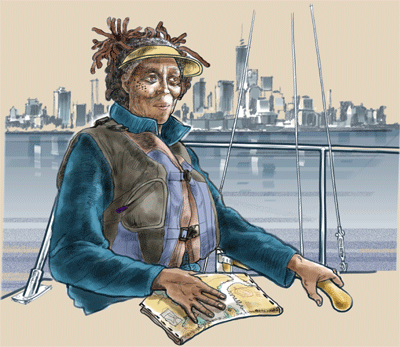
OPB All-Star: Janine Georgette
Humans of New York is an extremely popular social media phenom telling personal stories matched with heartfelt portraits. They recently did a widely shared post about Janine Georgette who told us, “I was a little discouraged about my prospects for learning to sail without any discretionary income, but the woman who has since become my sailing mentor suggested that I build a boat, a little PD Racer (Puddle Duck), and learn that way.
“That’s when I found out that Hudson River Community Sailing offered an after-school program with a boatbuilding component and they were looking for volunteers to work with kids.” Volunteers get free sailing lessons, so Janine had found a way to get her hand on a tiller after all.
OPB All-Star: Joshua Madrone Berger
Joshua Madrone Berger is a native New Yorker who volunteered aboard CLEARWATER, then went on to combine environmental education with seafaring. He became a professional captain aboard ADVENTURESS, but he has since moved on—a few years ago he became the Washington State Governor’s Maritime Sector Lead for the Department of Commerce.
Volunteer crew on ADVENTURESS—or “interns,” as they are called—aren’t paid but get meals and a place to stay. They are trained by people who are knowledgeable in sailing, ship handling and maintenance, galley work, and environmental education. They also work hard alongside others.
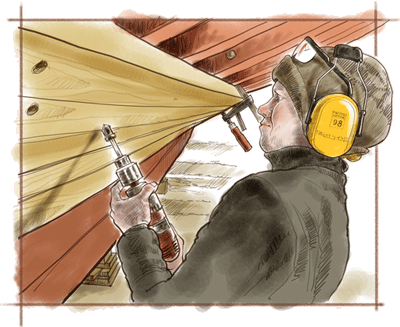
OPB All-Star: Esther Williams
Esther Williams, who started crewing for LADY WASHINGTON at age 12, volunteered on ADVENTURESS, and went on to become the first mate. She has also crewed on a voyage from Alaska to Norway. She and two other deckhands who worked as volunteers at Haven Boat Works, Brad Seamans and Jennifer Grod, eventually joined the boatyard’s full-time staff.
Suggested Projects on WoodenBoat’s Radar
- Maritime Museum of San Diego. Fairly new galleon reconstruction
- Sail, Power, & Steam Museum in Rockland, Maine. Friendship sloop recently restored, needs crew and maintenance
- The Center for Wooden Boats in Seattle, Washington. Small craft maintenance and repair
- Come Boating! in Belfast, Maine. Caring for rowing gigs
- Lake Champlain Maritime Museum (see WB No. 216). Caring for their collection of boats
- Dolphin Swim & Boat Club in San Francisco (see WB No. 217). Caring for rowing craft
- Chesapeake Bay Maritime Museum. “Apprentice for a Day” program; may involve registering for a class or having a membership
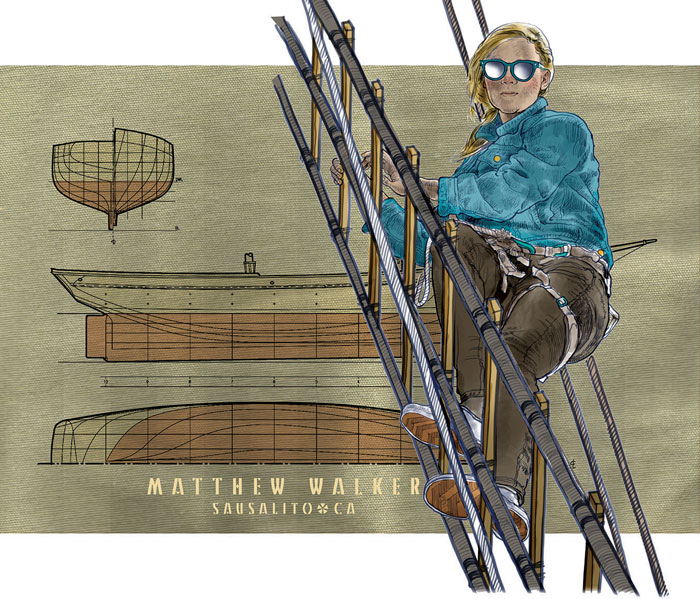
Elie Lewis, volunteer rigger on the MATTHEW TURNER.
One thing leads to another.
Here’s our best advice: Do one thing.

